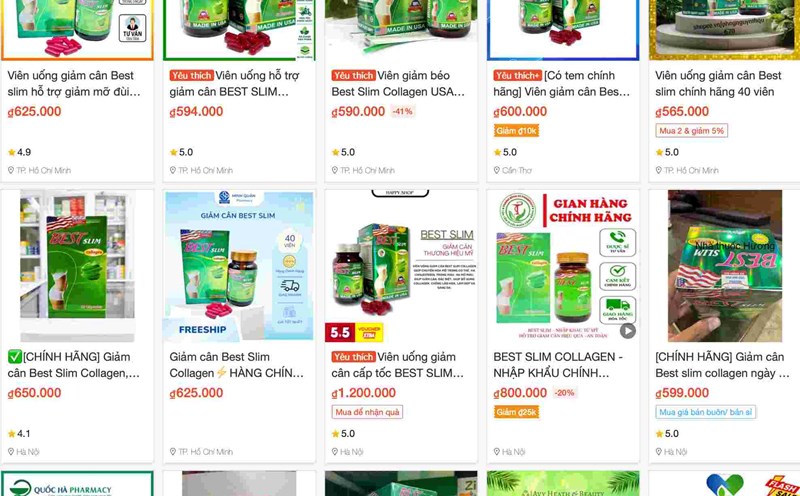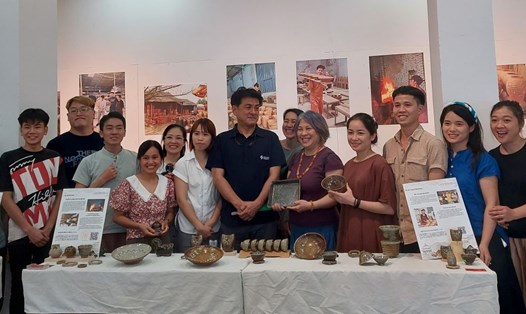Traveling on National Highway 5 bustling with traffic, few people expected that behind the rows of high-rise buildings close to the roadside of Ban village (now in Ban Yen Nhan ward, My Hao town, Hung Yen province) there was still a large yard filled with traditional diced soy sauce.
When the sun rises, the people of Ban village open their mouths, their hands windingly stirring them up, giving off a faint aroma from the yard to the alley, making anyone who comes to the village to enjoy the dish of rice with a bowl of Ban soy sauce.
Mr. Nguyen Khanh Dien, 55 years old, owner of a famous soy sauce making facility in Ban village, said that the craft of making soy sauce has appeared here for a long time. "Like my family, it is my third generation in the profession. Previously, like many other households in the village, the elderly in the house only made 1-2 small soy saucepasses a year to eat, then passed down through generations to start making more to sell, said Mr. Dien.
According to Mr. Dien, the area where the brick yard was dried for a few hundred taels of soy sauce before was rice fields. The people of Ban village used to be mainly farmers. When the vast fields were replaced by high-rise buildings, soy sauce was no longer just for eating but became a product that brought in the main income for many households in Ban village.
The soy sauce making facility of Mr. Dien's family and many other households currently has to hire more workers to make enough supply to the market. In a small house filled with lights, Ms. Nguyen Thi Sang (56 years old, Hung Yen) who has worked at Mr. Dien's soy sauce facility for more than two decades said: "To make a delicious batch of Ban soy sauce, in addition to the technique, experience depends a lot on the weather".




Currently, the villagers of Ban Mua make soy sauce all year round, every crop of other crops, but the main season must be from March - August of the lunar calendar. This time is the most sunny, convenient for mold and soy drying. "The weather is very important, and the ingredients are simple, only glutinous rice, soybean and salt. Rice and beans used to be the people in the village to plant themselves," said Sang.
Ingredients for making Ban village soy sauce are not difficult to find, but you need to choose. The sticky rice is large, round, and has a turbid white color. The soy sauce is evenly arranged, not moldy, broken. The salt is usually taken from below Thai Binh, white starch without incident. I heard that in the days of the elders, they used to use village well water and longan leaves to cover the markers, but now there are no more, said Mrs. Mi - another worker in Mr. Diens family.
The construction process is meticulous and has many steps. But for those born from soy sauce like Mrs. Sang, who were able to watch their grandmothers and mothers make soy sauce when they were young, Mrs. Sang told me a story: The first step of making soy sauce is making a mark. The roasted soybeans are fragrant and fragrant, then peeled and pureed, poured in a pot of water for a week.
After soaking for about 4 hours, the sticky rice is put into the pot, the dishes are cooked in one and a half hours. When things need attention, leaving the sticky rice to break too much soy sauce will turn black, if too much is raw, it will turn sour. The sticky rice is just cooked, poured into a tray, simmered, let cool and then covered with a clean bag.
Sticky rice after a day of incubation, rubbing and rubbing for 1-2 days. When the sticky rice is white, the person continues to repeat the technique of squeezing, rubbing gently so that the sticky rice seeds are evenly molded, then brewed for about 2 days to make the flower mold. According to Ms. Sang, in the sunny season, it only takes about 4 days to go to the flower mold, but the cold season sometimes has to be a week. When the sticky rice is the right color of the yellow flower, the person continues to squeeze it, add it to the previous spoon of water, mix well and then incubate for 1 day 1 night.
"When the mold is available, it will take away. In the jar of 100 liters, the ratio is 30kg of molded rice, 10kg of ground beans, 15kg of salt and stir well." Mrs. Sang said as she opened the jar lid so that I could watch it live. During the first month, in the morning, the maker had to open the jars, stir the soy sauce continuously so that the sauce would sink, the juice emerged, and the sun would cover. If it is raining, there is no need to stir, because the adhesive jars will be white.
The tubers are exposed to the sun for about 3 months to eat. Not having enough days, soy sauce, uneven colors, and even white grains. When the soy sauce is fully cooked, stirring, the wave soy sauce is golden yellow, with a gentle aroma. "Black water" - as Ms. Sang calls the above water with soy sauce is the most suitable for fish storage, helping the fish to be soft and fragrant.
The soy sauce is dipped in local dishes such as banh da, rau boiled, beef... with a rich salty taste and the sweetness and aroma of rice and beans. So, every time I hear the song: "Oh my hometown, many banh da chuc" or "I miss my hometown/I miss growing water spinach and water spinach, I miss soy sauce", everyone remembers the simple dish of rice with a bowl of rustic soy sauce, which is not as good as the taste of the hometown.
From a purely agricultural village, the space of Ban village has changed a lot today. In addition to maintaining the long-standing experience of making soy sauce, traditional soy sauce making has also applied machines such as boilers, roasters, and grinder to make some soy sauce steps faster, meeting the quantity while still ensuring the same quality to customers.
In addition to selling products, Ban villagers actively promote the culture of soy making whenever customers visit. The yard of hundreds of soap trays lined up, straight with the ancient beauty of Mr. Dien's house has become a tourist destination for many domestic and international tourists. Or at Ms. Hanh's soy sauce making facility, on many occasions, her family welcomes young people to play, both experiencing the soy sauce making process and learning about Ban village, about the land of Hung Yen with a strong historical and cultural imprint.










